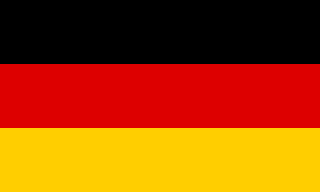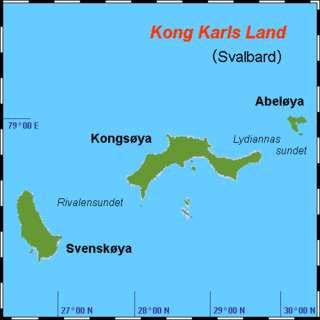
Fram ("Forward") is a ship that was used in expeditions of the Arctic and Antarctic regions by the Norwegian explorers Fridtjof Nansen, Otto Sverdrup, Oscar Wisting, and Roald Amundsen between 1893 and 1912. It was designed and built by the Scottish-Norwegian shipwright Colin Archer for Fridtjof Nansen's 1893 Arctic expedition in which the plan was to freeze Fram into the Arctic ice sheet and float with it over the North Pole.
The polar archipelago of Svalbard was first discovered by Willem Barentsz in 1596, although there is disputed evidence of use by Pomors or Norsemen. Whaling for bowhead whales started in 1611, dominated by English and Dutch companies, though other countries participated. At that time there was no agreement about sovereignty. Whaling stations, the largest being Smeerenburg, were built during the 17th century, but gradually whaling decreased. Hunting was carried out from the 17th century by Pomors, but from the 19th century it became more dominated by Norwegians.

Dr Alfred Gabriel Nathorst HFRSE FLS FGS was a Swedish Arctic explorer, geologist and palaeobotanist.

Edgeøya, occasionally anglicised as Edge Island, is a Norwegian island located in southeast of the Svalbard archipelago; with an area of 5,073 square kilometres (1,960 sq mi), it is the third largest island in this archipelago. An Arctic island, it forms part of the Søraust-Svalbard Nature Reserve, home to polar bears and reindeer. Its eastern side is covered by an ice field. The island is named after Thomas Edge, an English merchant and whaler. It is seldom visited today.
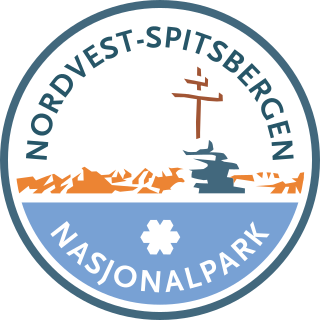
Nordvest-Spitsbergen National Park is located on the Norwegian arctic archipelago of Svalbard and includes parts of north-west Spitsbergen and nearby islands such as Danes Island and Moffen. It contains, among other things, warm springs and remains of volcanoes in Bockfjorden.

Andrée's Arctic balloon expedition of 1897 was an effort to reach the North Pole in which all three expedition members perished. S. A. Andrée, the first Swedish balloonist, proposed a voyage by hydrogen balloon from Svalbard to either Russia or Canada, which was to pass, with luck, straight over the North Pole on the way. The scheme was received with patriotic enthusiasm in Sweden, a northern nation that had fallen behind in the race for the North Pole.

Danes Island is an island in Norway's Svalbard archipelago in the Arctic Ocean. It lies just off the northwest coast of Spitsbergen, the largest island in the archipelago, near to Magdalenefjorden. Just to the north lies Amsterdam Island. Like many of Svalbard's islands, Danes Island is uninhabited. The island has an area of 40.6 km2 (15.7 sq mi).
The BratvaagExpedition was a Norwegian expedition in 1930 led by Dr. Gunnar Horn, whose official tasks were hunting seals and to study glaciers and seas in the Svalbard Arctic region. The name of the expedition was taken from its ship, M/S Bratvaag of Ålesund, in which captain Peder Eliassen had sailed the Arctic seas for more than twenty years. The Bratvaag Expedition had a secret, but important mission: the annexation of Victoria Island for Norway. Although a successful landing on the island was achieved, Victoria Island was later annexed by the Soviet Union. The Bratvaag Expedition became nevertheless well-known due to the findings on Kvitøya of the long-lost remains of the Swedish explorer S. A. Andrée's Arctic balloon expedition of 1897.
Gunnar Hansen Horn was a Norwegian petroleum geologist and Arctic explorer. He is most renowned as the leader of the Bratvaag Expedition that found the long-lost remains of S. A. Andrée's Arctic balloon expedition of 1897 at Kvitøya in 1930. The headland Hornodden of Kvitøya is named after him.
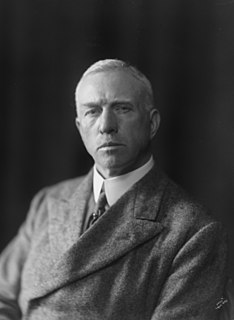
Gunnerius Ingvald Isachsen, was a Norwegian military officer and polar scientist. From 1923, he was the first president of the Norwegian Maritime Museum.
Virgohamna is a small bay on the northern coast of Danes Island, an island off the northwestern coast of Spitsbergen. Spitsbergen and Danes Island are islands of the Svalbard archipelago. The bay is named after SS Virgo, the vessel of Swedish engineer and explorer Salomon August Andrée's 1896 expedition. Virgohamna is located across a small strait from Smeerenburg, a historical whaling station on Amsterdam Island about 2 km to the north.

Salomon August Andrée, during his lifetime most often known as S. A. Andrée, was a Swedish engineer, physicist, aeronaut and polar explorer who died while leading an attempt to reach the Geographic North Pole by hydrogen balloon. The balloon expedition was unsuccessful in reaching the Pole and resulted in the deaths of all three of its participants.

Andrée Land is the land area between Wijdefjorden and Woodfjorden on Spitsbergen, Svalbard in Arctic Norway. Limited in the south by a line from Woodfjorden through Vonbreen to Holtedahlfonna eastwards to the upper part of Abrahamsenbreen through Ruskbreen, Millarpasset, Lisbetbreen and Vestfjorddalen to Vestfjorden.
Bohemanneset is a cape defined by the southeastern spit of Bohemanflya, located at the northwestern side of Isfjorden, in Oscar II Land on Spitsbergen, Svalbard. It is named after Swedish entomologist Carl Henrik Boheman. Bohemanneset has a length of about 2 km (1.2 mi). Older names are Cap Boheman and Cape Boheman.

The Spitsbergen Airship Museum is a museum located on the island of Spitsbergen in Longyearbyen, the capital of the Arctic Ocean archipelago Svalbard. It has been formally renamed as the North Pole Expedition Museum. It was co-founded by the Italian Stefano Poli and the Norwegian Ingunn Løyning. Plans to open the museum began in 2005. Originally a new building was supposed to be built to house the museum, but following a fallout with one of the share-owners in 2007 this idea was scrapped, and instead the Airship Museum was opened in 2008 in Longyearbyen's former pig farm, which previously had housed the Svalbard Museum as well.
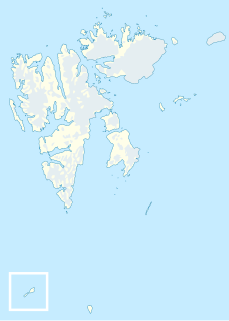
Cape Weyprecht is a headland in the northeast part of Spitsbergen in Svalbard, in the area known as Olav V Land.

Koner Island is a minor island in the Bastian Islands in the Svalbard archipelago. It lies east of Wilhelm Island and northeast of Spitsbergen.
